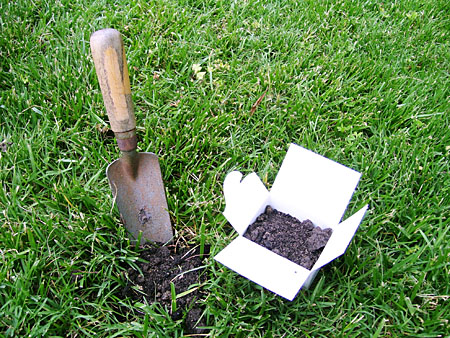The Real Dirt on Soil Testing
go.ncsu.edu/readext?862762
en Español / em Português
El inglés es el idioma de control de esta página. En la medida en que haya algún conflicto entre la traducción al inglés y la traducción, el inglés prevalece.
Al hacer clic en el enlace de traducción se activa un servicio de traducción gratuito para convertir la página al español. Al igual que con cualquier traducción por Internet, la conversión no es sensible al contexto y puede que no traduzca el texto en su significado original. NC State Extension no garantiza la exactitud del texto traducido. Por favor, tenga en cuenta que algunas aplicaciones y/o servicios pueden no funcionar como se espera cuando se traducen.
Português
Inglês é o idioma de controle desta página. Na medida que haja algum conflito entre o texto original em Inglês e a tradução, o Inglês prevalece.
Ao clicar no link de tradução, um serviço gratuito de tradução será ativado para converter a página para o Português. Como em qualquer tradução pela internet, a conversão não é sensivel ao contexto e pode não ocorrer a tradução para o significado orginal. O serviço de Extensão da Carolina do Norte (NC State Extension) não garante a exatidão do texto traduzido. Por favor, observe que algumas funções ou serviços podem não funcionar como esperado após a tradução.
English
English is the controlling language of this page. To the extent there is any conflict between the English text and the translation, English controls.
Clicking on the translation link activates a free translation service to convert the page to Spanish. As with any Internet translation, the conversion is not context-sensitive and may not translate the text to its original meaning. NC State Extension does not guarantee the accuracy of the translated text. Please note that some applications and/or services may not function as expected when translated.
Collapse ▲We all know what dirt is. It is sometimes used in reference to a secret about someone, but we are talking about real dirt here, soil. So what is so important about soil testing? Some background information can help us understand the benefits and find what we need to know about the real dirt beneath our feet.
Soil is a natural, living, breathing, self-contained substance that is composed of solids, liquids and gases. One of its main functions is to provide a medium with structural stability to enable plants to grow. Naturally occurring soils consist of layers of topsoil, subsoil, and parent materials which will vary in thickness and substance depending on your location. In North Carolina, parent materials range from decomposing bedrock in our mountains to marine sediments near the coast. Difference in parent material, climate, biological activity, topography and time will result in different soil types. More than 450 unique soil series are currently mapped in North Carolina.
Physical properties of soils such as color, texture, structure and water-holding capacity cannot be easily changed, however, a soil’s fertility, which is a chemical property, can be. Soil testing measures the relative acidity (pH) and level of essential nutrients (phosphorus, potassium, calcium, magnesium, sodium, sulfur, manganese, copper and zinc) that are needed for plant growth. Different plants require different pH levels for optimum growth and productivity. North Carolina soils tend to be acidic as is most of the southeast. Without lime, pH is most often in the 4.5 to 5.5 range. Acid-loving plants like azaleas, blueberries and centipedegrass are well-suited here with a pH level from 5.0 to 5.5. But for most plants in North Carolina, the ideal level of pH is from 6.0 to 6.5. If soil pH is above or below their preferred range, plants may not be able to use nutrients available in the soil whether they are added or occur naturally. Over application of nutrients that plants cannot use can leach into the groundwater or run off into surface waters like rivers and streams. Plants may develop problems such as diseases, insects, nutrient deficiencies and dieback. Soil testing can eliminate the guesswork and provide an accurate guidance for applying fertilizer or adjustments to pH.
So, how do you take a soil sample? Forms and sample boxes can be obtained from your local extension office. Determine where you need to sample. Flower beds, vegetable gardens, home orchards and lawns need to be sampled separately. Use non-reactive tools such as stainless steel or chrome-plated for digging and a clean  plastic bucket for collection. Remove leaves and mulch and any other debris from the surface. Dig a hole to the appropriate depth of each type of plant and scrape soil from the side of the hole – one stroke, bottom to top. For vegetable gardens and flower beds, dig 6 to 8 inches deep. For trees and shrubs, 6 to 10 inches and for established lawns, 4 inches deep. Repeat this method in 6 to 8 areas and combine them for a complete representative sample. Mix the subsamples together to have one composite sample. If only one type plant is to be tested, list it specifically. If you have areas with different soil types, test them separately. Don’t take a sample when the soil is wet, it will damage the collection box in transit and may contaminate the results. Keep a record of the areas being sampled and code them accordingly so you can remember where each was taken. Return boxes and form or forms to the extension office which will forward them to the NC State Agronomics Service for analysis. For more information, contact N.C. Cooperative Extension in Lee County.
plastic bucket for collection. Remove leaves and mulch and any other debris from the surface. Dig a hole to the appropriate depth of each type of plant and scrape soil from the side of the hole – one stroke, bottom to top. For vegetable gardens and flower beds, dig 6 to 8 inches deep. For trees and shrubs, 6 to 10 inches and for established lawns, 4 inches deep. Repeat this method in 6 to 8 areas and combine them for a complete representative sample. Mix the subsamples together to have one composite sample. If only one type plant is to be tested, list it specifically. If you have areas with different soil types, test them separately. Don’t take a sample when the soil is wet, it will damage the collection box in transit and may contaminate the results. Keep a record of the areas being sampled and code them accordingly so you can remember where each was taken. Return boxes and form or forms to the extension office which will forward them to the NC State Agronomics Service for analysis. For more information, contact N.C. Cooperative Extension in Lee County.
Ideally, soil tests should be taken several months before planting or fertilizing. Sandy soils should be tested every 2 to 3 years and clay soils every 3 to 4 years. Beginning in April and through November, the tests are free of charge. Soil testing is the most dependable way to find out what our plants need and how we can help them stay healthy. Now you have permission to go play in the dirt.
Gail Griffin is an Extension Master Gardener℠ Volunteer with N.C. Cooperative Extension, Lee County Center.




